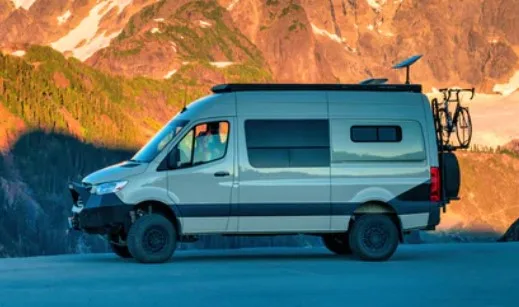If you buy a van conversion online from a private seller and it’s located hundreds or even thousands of miles away, traveling to pick it up can be time-consuming and exhausting. Fortunately, you can have it delivered to your home with minimal effort on your part.
The most crucial aspects of transporting a campervan or any kind of convertor van is the kind vehicle it’s as well as its overall dimensions. Small camper vans as well as the majority of medium-sized camper vans are transported together a standard open-air vehicle carrier. larger camper vans, like ones that are classified as classified as a Class B RV must be transported with the designation of “oversized vehicle” on a flatbed car carrier. If you’ll be able to transport your van on an open carrier plays an important part in the total shipping costs. It may also impact the length of time required to deliver via a van, since flatbed shipping typically takes longer to complete.
Understanding Vehicle Size Limits for Open-Air Shipping
Most vehicle shipping companies transport vehicles under 7 meters long, 2.4 meters tall, or 2.4 meters wide on an open-air carrier. Here’s a breakdown of camper van sizes to help determine if they fit on an open-carrier for shipping:
- Micro campervan Length: 4.3 – 4.9 meters Width: 2.0 – 2.2 meters Height: 1.8 -1.9 meters
- Campervans of a small size Dimensions: 4.6 – 5.0 meters Width: 1.9 – 2.3 meters Height: 1.9 – 2.4 meters
- Medium campervan – Length: 5.2 – 6.0 meters Width: 2.4 – 2.5 meters Height: 2.2 – 2.8 meters
- Large campervan – Length: 5.9 – 7.4 meters Width: 2.4 – 2.5 meters Height: 2.6 – 3.1 meters
- Box-van campervan – Length: 6.1 – 7.2 meters Width: 2.1 – 2.5 meters Height: 3.0 – 3.5 meters
By reviewing the list and considering the dimensions suitable for an open carrier, you’ll find that all micro-campervans and small campervans can be transported on an open carrier. Most medium-sized campervans also fit, but larger or box-style campervans may not be suitable for open transport.In general, the campervan that has bathroom facilities will likely be close to the limit of dimensions for open carriers, which means you’ll need to determine the precise dimensions.
Setting Up Your Camper Van Conversion Shipment
One of the best things about transporting a conversion van or any vehicle is how little effort is required on your part. To schedule and book your delivery, start by outlining your needs, researching different companies, and contacting the one you choose by phone. You’ll need to know the exact dimensions, size, and model of your van, along with your preferred pick-up and delivery times and addresses. These details will be necessary when making your reservation. While researching, check online reviews on sites like Google for the companies you’re considering. Visit their websites to confirm they offer shipping within Canada, then request a quote either online or by phone. This will allow you to compare rates from companies with good reviews and make an informed decision.
Then, you should reach out to the company you’ve chosen to ship with to arrange for your delivery. Remember that the times of pickup and delivery will be two to three days, not for sure precise dates. Unpredictable events like weather and traffic prevent businesses from being able guarantee certain dates and times.
The Cost of Shipping a Camper Van
The total cost of shipping a campervan can vary due to a variety of different variables, including the weight and size of the vehicle. Other variables include the time of the year that you will be shipping your conversion vehicle and the cost of gasoline at the time you are shipping your cargo as well as the shipping options you picked, and also the amount of notice about the shipment you provided to the shipping company that you used to ship your vehicle.
These elements can result in the cost of your package to fluctuate throughout the year. Therefore the perfect choice is to obtain no-cost quotes from other companies, and then pick the one that is accurate to your needs. Transporting a van using an open vehicle (if it is small sufficient) costs approximately CA$0.4 up to CA$2.2 per km. If you have a larger camper van conversion that requires shipping on a flatbed trailer, the cost can range from CA$1.0 to CA$4.5 per kilometer.
In the majority of cases, shorter distance shipments between 250 and 700 kilometers cost more per kilometer than larger distance shipments that go over 1000 kilometers. For instance, if we assume that all factors that impact the price of transporting vehicles were in the average range when a shipment and shipping an unassuming camper van between Montreal to Toronto (approximately 500 km) using the open transporter would run around CA$1.8 per kilometer and about CA$900 total. For comparison shipping the same scenario with the same scenario to Montreal up to Winnipeg (approximately 1100 km) will cost around CA$1.2 per kilometer and about CA$1,325 total.
How You Can Preserve Money When Shipping a Van
One of the primary goals is to keep the price to a minimum when transporting a campervan, you can take a few steps to save the maximum amount of dollars. The first is to do it your excellent to ship at a time of year when shipping companies are less crowded, for instance between October and February. Vehicle transportation services are in high demand from May through September, so it’s best to avoid shipping during these months if possible.
Also, you should try to stay clear of any expensive shipping options, if feasible. If you’re transporting a small camping vehicle and are able to transport it via uninvolved carriers, then do this. Don’t ship the vehicle in a closed carrier or opt to top load it, since these options could increase the cost by several hundred dollars the total cost. Make sure you confirm and secure your van’s shipment at least one month prior to the date the date you’d like it to be picked up. It is possible to reserve a van shipment with just one or two days of notice but it will be more expensive to secure a space on the transporter as there will be less available carriers and space on these carriers.
How You Can Ready for Your Camper Van Shipment
The process of preparing to transport a camper van will require some time and effort. This process includes cleaning the van’s exterior, removing any personal items or loose parts, and ensuring it has only half a gallon of gas. The exterior must be clean so the driver can inspect it for any pre-existing damage before shipping, which is important for insurance purposes to avoid covering any prior damage.
Removing personal items and loose parts is essential to ensure insurance coverage. Take out items like glasses, plates, gloves, portable speakers, and anything critical to the van’s operation, as they won’t be insured if damaged during transit. Prepare the van by leaving a quarter tank of fuel—enough to drive on and off the transporter, but anything more can pose a fire risk during transport.
If you’re buying an RV from our team on Paved To Pines, we can manage the entire transport procedure from our shop to returning to your home at no cost for you.

